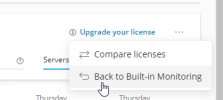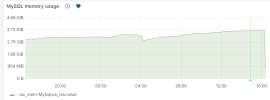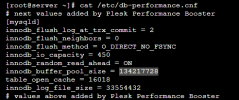-
If you are still using CentOS 7.9, it's time to convert to Alma 8 with the free centos2alma tool by Plesk or Plesk Migrator. Please let us know your experiences or concerns in this thread:
CentOS2Alma discussion
You are using an out of date browser. It may not display this or other websites correctly.
You should upgrade or use an alternative browser.
You should upgrade or use an alternative browser.
Question How to monitor CPU per domain/subscription?
- Thread starter tanasis
- Start date
Hi,
Have you seen How to Use Cgroups Manager to Increase Website Performance
Unfortunately, if you did not configure it in the past, it is not possible to see data for the past 7 days. But if you enable that feature, it will be possible to analyze CPU metric per subscription.
Have you seen How to Use Cgroups Manager to Increase Website Performance
Unfortunately, if you did not configure it in the past, it is not possible to see data for the past 7 days. But if you enable that feature, it will be possible to analyze CPU metric per subscription.
@AYamshanov I have enable 360 Monitoring (Lite license), shall I have to go "Back to Built-in Monitoring" ?


Yes, unfortunately, it is not possible now to see cgroups metrics via 360 Monitoring,
But it possible to see subscription metrics in Plesk with Built-in Monitoring and keep agent360 running and see metrics collected with agent360 on the 360 Monitoring website, Plesk 360 at the same time. Hope it helps you.
But it possible to see subscription metrics in Plesk with Built-in Monitoring and keep agent360 running and see metrics collected with agent360 on the 360 Monitoring website, Plesk 360 at the same time. Hope it helps you.
Thank you @AYamshanov for you reply. I think the "classic" is better than 360 lite.
I have one more question. As you can see, SQL memory is lower than 4GB.
I want to increase it and and do it 10GB.
How can do this in Plesk ?

I have one more question. As you can see, SQL memory is lower than 4GB.
I want to increase it and and do it 10GB.
How can do this in Plesk ?

If the expectation is that with a larger innodb_buffer_pool the database will become faster, that will not necessarily happen. A large buffer can also mean more load to work with the buffer. It can have the opposite effect, it can slow the server down.
If the values that Performance Booster suggests don't seem right, it coudl be good to install MySQLTuner GitHub - major/MySQLTuner-perl: MySQLTuner is a script written in Perl that will assist you with your MySQL configuration and make recommendations for increased performance and stability., run it and let it monitor database actions for a long while. Then check the results. It will make suggestions for optimal settings.
If the values that Performance Booster suggests don't seem right, it coudl be good to install MySQLTuner GitHub - major/MySQLTuner-perl: MySQLTuner is a script written in Perl that will assist you with your MySQL configuration and make recommendations for increased performance and stability., run it and let it monitor database actions for a long while. Then check the results. It will make suggestions for optimal settings.
Thank you Peter for your reply.
I ran the tuner and I have these suggestions:
So...
1) What is "User 'example_ocar938'@% does not specify hostname restrictions." ?
2) What is this "RENAME USER 'example'@'%' TO 'example'@LimitedIPRangeOrLocalhost;" ?
3) In Variables to adjust, I see "innodb_buffer_pool_size (>= 9.7G) if possible"
I ran the tuner and I have these suggestions:
Code:
User 'example_ocar938'@% does not specify hostname restrictions.
RENAME USER 'example'@'%' TO 'example'@LimitedIPRangeOrLocalhost;
MySQL was started within the last 24 hours: recommendations may be inaccurate
Configure your accounts with ip or subnets only, then update your configuration with skip-name-resolve=ON
We will suggest raising the 'join_buffer_size' until JOINs not using indexes are found.
See MySQL :: MySQL 8.0 Reference Manual :: 5.1.8 Server System Variables
When making adjustments, make tmp_table_size/max_heap_table_size equal
Reduce your SELECT DISTINCT queries which have no LIMIT clause
Performance schema should be activated for better diagnostics
MyISAM engine is deprecated, consider migrating to InnoDB
Before changing innodb_log_file_size and/or innodb_log_files_in_group read this: MySQL :: MySQL 8.0 Reference Manual :: 15.6.5 Redo Log
Variables to adjust:
skip-name-resolve=ON
join_buffer_size (> 256.0K, or always use indexes with JOINs)
tmp_table_size (> 16M)
max_heap_table_size (> 16M)
table_definition_cache (400) > 24515 or -1 (autosizing if supported)
performance_schema=ON
innodb_buffer_pool_size (>= 9.7G) if possible.So...
1) What is "User 'example_ocar938'@% does not specify hostname restrictions." ?
2) What is this "RENAME USER 'example'@'%' TO 'example'@LimitedIPRangeOrLocalhost;" ?
3) In Variables to adjust, I see "innodb_buffer_pool_size (>= 9.7G) if possible"
As far as I remember, running that script required a rather long-term observation, e.g. a day or two. Else no suitable values can be found.
1) It means that this user can access the database from any sources (ips).
2) It means that you could limit the user to a specific source ip or range.
In my opinion both these options are pretty useless regarding speed optimization.
3) Give it a try. But again: I wonder how these values could be found so fast. Normally, with all database transactions going on during a day, serveral situations can occur that require different settings.
1) It means that this user can access the database from any sources (ips).
2) It means that you could limit the user to a specific source ip or range.
In my opinion both these options are pretty useless regarding speed optimization.
3) Give it a try. But again: I wonder how these values could be found so fast. Normally, with all database transactions going on during a day, serveral situations can occur that require different settings.
1) It means that this user can access the database from any sources (ips).
2) It means that you could limit the user to a specific source ip or range.
Peter, how can I fix them ?
You can easily set the user permissions in the Plesk graphical user interface. The user is a database user, so simply go to the database user page of the affected domain and change that user to allow localhost access only.
I have two users and I can't find them...
[!!] User 'wp_cfygp'@% does not specify hostname restrictions.
[!!] User 'wp_hk1iq'@% does not specify hostname restrictions.
How can I find them ?
Those users are defined in wp-config.php of the related WordPress installations.
Do something like this to find the users:
Code:
# grep -E 'wp_cfygp|wp_hk1iq' /var/www/vhosts/*/httpdocs/wp-config.phpSimilar threads
- Replies
- 1
- Views
- 142
- Replies
- 4
- Views
- 228
- Replies
- 12
- Views
- 585


